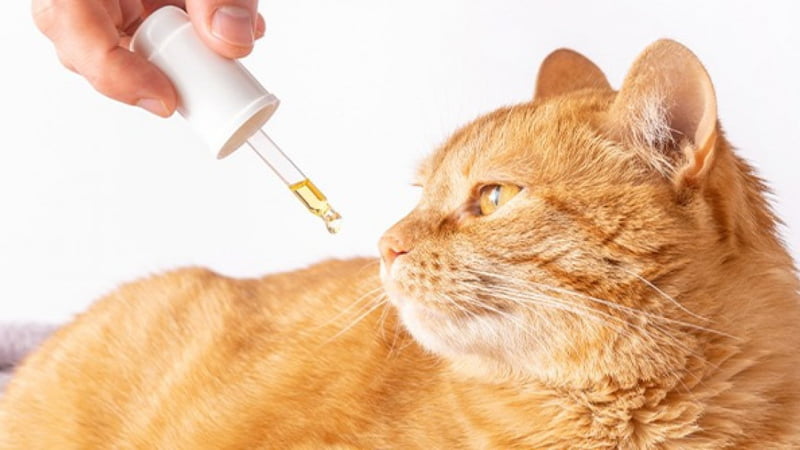CBD Oil For Cats With Kidney Disease: Is it Safe & Effective?

Cats, especially our senior feline friends, also develop kidney disease. If your pet has been diagnosed with this medical condition, then know that CBD oil can help. It has many therapeutic effects that can help relieve symptoms of kidney diseases.
In this article, we’ll discuss how CBD oil helps cats with kidney disease and how to get the right dosage for them.
Cats and Kidney Disease
The main function of the kidneys is to filter the blood. The important compounds go back into the bloodstream, while the waste products go to the bladder and become part of the urine.
As your cat ages, the kidneys also start to deteriorate, affecting the way it normally functions. The more damage the kidneys sustain, the higher the risk of developing kidney disease.
According to one study, chronic kidney disease is considered one of the most common diseases that affect domesticated cats, especially those who are more than 12 years of age. Senior cats, the study continues, are more prone to chronic kidney disease than dogs, and the prevalence is increasing yearly.
Other causes of kidney disease in cats include genetics, bacterial infection, autoimmune problems, heart dysfunction, trauma to the pelvic region, blockages, ingestion of toxic substances, chronic dehydration, among others.
What are the Symptoms of Cat Kidney Disease?
When your cat’s kidneys start deteriorating, it will no longer be able to filter blood properly. The waste products start leaking and accumulate in the bloodstream, causing the symptoms of kidney disease. These include:
- Lethargy and weakness
- Loss of appetite with weight loss
- Anxiety, stress, and even depression
- Vomiting, which may sometimes contain blood
- Diarrhea, which sometimes contains blood
- Excessive thirst
- Chronic dehydration
- Bad breath
- Pain in the region of the kidneys, characterized by an arched back and stiff gait
- Infrequent, diminished, or absent urination
If left untreated, chronic kidney disease results in kidney failure and even death.
How is Chronic Kidney Disease in Cats Treated?

There’s no cure for cat chronic kidney disease.
However, medications may be given to at least reduce symptoms and slow down the disease progression. Vitamins and supplements may also be administered to correct a chemical imbalance in the body.
Today, an increasing number of pet owners are looking for CBD oil for cats with kidney disease and are using it, saying that it helps improve their cat’s quality of life.
How does CBD oil benefit cats with kidney disease? Is it safe? How do you give CBD oil to your cat?
Cat’s Endocannabinoid System
Studies show that all mammals, which include cats, have an endocannabinoid system (ECS).
The ECS helps keep the balance between the excitatory and inhibitory chemicals in the body. Any imbalance between these two may result in symptoms.
For example, kidney disease not only causes electrolyte imbalance but also affects the neurotransmitter levels in the brain. This causes motor problems, seizures, and even coma.
Now, the ECS works to correct this imbalance, resulting in symptom control.
Similar to the human ECS, the cat’s ECS is also made up of three components.
Endogenous Cannabinoids
When there’s a noxious stimulus like pain and infection, the cells release endogenous cannabinoids or endocannabinoids. These compounds bind to the cannabinoid receptors found on the cells.
Cannabinoid Receptors
There are two types of cannabinoid receptors — CB1R and CB2R.
Although found all over the body, the brain and spinal cord contain the highest concentrations of CB1Rs. Their activation in the brain helps control many physiological responses, from appetite and sleep to pain and anxiety. The CB1R is also the receptor that THC stimulates to produce hallucinogenic, psychoactive, mind-altering effects.
The CB2R, on the other hand, is mostly located in the immune cells. Its activation produces a powerful anti-inflammatory effect.
Enzymes
Activation of the ECS helps control many symptoms, but its effects are short-lived because the endocannabinoids are easily degraded by the enzymes. The cells also quickly reabsorb the degraded endocannabinoids.
How Does CBD Oil Benefit Cats with Kidney Disease?

The therapeutic effects of the endocannabinoids are short-lived. They’re quickly degraded by the enzymes for reabsorption back into the cells.
Now, CBD produces many therapeutic effects that benefit cats with kidney disease. It may not directly activate the CB1R, but it works on the CB2R as well as several receptors that control our responses to stimulus.
Below are some of its benefits.
Pain Control
If you notice your cat walking with a stiff-legged gait and an arched back, then your pet might be suffering from kidney pain.
Giving CBD oil helps reduce your cat’s kidney pain. It stimulates the receptors controlling pain, and when these are activated, they prompt the cells to reduce their release of pain-generating chemicals.
Decrease in Low-Grade Inflammation Within the Body
Damaged kidney cells release pro-inflammatory chemicals. These chemicals attract more immune cells to the injured site, causing low-grade inflammation of the kidneys. The longer the kidneys are in a state of chronic inflammation, the more damage it can cause the organ. Not only can low-grade inflammation cause more symptoms, but it can also speed up disease progression.
By stimulating the CB2R and other receptors on the immune cells, CBD reduces low-grade inflammation. Their activation signals the immune cells to stop releasing chemicals that contribute to inflammation. CBD also triggers chemical changes within the immune cells that lead to cell death.
Relief from Stress, Anxiety, and Depression
The most common cause of mood changes in cats is separation anxiety. This problem can be addressed by spending more time with your cat or through behavior modification changes.
If the cause is unknown though, then your cat might be suffering from an underlying medical condition, one of which is kidney disease.
CBD offers relief from anxiety and depression for cats. It stimulates the brain receptors that modulate mood, fear, and anxiety, and stress. CBD also promotes balance between the excitatory and inhibitory chemicals in the brain.
These effects make your cat feel calmer.
Decrease in Vomiting
The buildup of waste products in the blood causes nausea and vomiting in your cat, affecting appetite and resulting in weight loss.
CBD helps control nausea and vomiting through its effects on the serotonin receptor. It also prevents conditioned gaping reactions caused by nausea.
Helps the Endocannabinoid System
Chronic health problems weaken the ECS, and a weakened ECS won’t be able to do its job of maintaining balance within the body.
CBD not only boosts the health of your cat’s ECS but also allows the endocannabinoids to stay longer inside the body. CBD attaches to the enzymes, preventing them from degrading the endocannabinoids.
Is CBD Oil for Cats with Kidney Disease Safe?

Yes, giving your cat CBD oil should be safe. Many pet owners who use CBD oil for cats with kidney disease report an improvement in their symptoms. There may be some side effects at first, but these are usually well-tolerated by our feline friends.
Don’t give your cat CBD oil with a high THC level. Not only is it toxic to cats, but THC also causes neurological side effects. THC affects their motor coordination. It may also cause agitation, aggression, and increased salivation.
As for the side effects, CBD may cause upset stomach and diarrhea in some cats. Motor incoordination may also occur, but this is common in CBD oils with high levels of THC.
Is It Legal to Use CBD Oil for Cats with Kidney Disease?
CBD oil derived from industrial hemp is legal under the 2018 Farm Bill, provided its THC content doesn’t exceed 0.3%. However, the market for pet CBD oil remains unregulated. This puts you at risk of buying inferior and maybe even contaminated pet CBD products that may be dangerous for cats.
To protect your cat’s health, you need to know how to choose a good CBD oil.
How Do You Choose CBD Oil for Cats with Kidney Disease?
How do you know you’re buying quality pet CBD oil? What are the factors to consider? Here are some guidelines to consider to find the best CBD product for your cat.
Source of the CBD Extract
For the safety of your cat, choose hemp-derived CBD that doesn’t contain any traces of THC. If the product contains THC, make sure that its level doesn’t exceed 0.3%.
Type of CBD Oils
You’ll encounter three types of CBD oil — pure, broad-spectrum, and full-spectrum CBD oil.
They all contain CBD. The only difference lies in the addition of extra cannabinoids and terpenes.
Pure CBD oil only contains CBD isolate, and no other ingredients.
Broad-spectrum and full-spectrum CBD oils both have additional cannabinoids and terpenes. However, full-spectrum CBD also has some THC in it (no more than 0.3%)
They can all help relieve your cat’s kidney disease symptoms. But for better symptom control, choose full-spectrum CBD oil. The addition of THC makes the CBD oil stronger since it enhances the beneficial properties of the other cannabinoids and terpenes.
Don’t worry about the THC content though. It’s a very low amount and won’t cause any mind-altering effects.
Laboratory Test Result
You’re not always assured of the pet CBD oil’s quality, especially since it’s an unregulated market.
To be safe, always choose pet CBD oils with certificates of analysis (COA). The COA means that the product underwent laboratory testing done by a certified third party.
The laboratory tests look for traces of pathogens, toxic residues, residual solvents, heavy metals, and artificial pesticides and fertilizers, among others. They also check the potency of the product and make sure that it does contain its stated cannabinoid profile and potency.
Stay away from pet CBD oils that don’t have COAs.
Reviews and Feedback
It’s also just as important to read reviews about the company and the products they’re making. These already give you a good idea of how effective the product is (or not!).
Again, avoid pet CBD oils that receive many negative reviews. If they’re not happy with it, you probably won’t be either.
What’s the Best CBD Oil Dosage for Cats with Kidney Disease?

There’s no approved recommended daily intake (RDI) for pet CBD oil yet, but experts recommend giving cats 1 mg (low dose for mild symptoms), 3 mg (medium dose for moderate symptoms), and 5 mg (high dose for severe symptoms) of CBD per 10 pounds of body weight.
For example, your Maine Coon cat weighs a hefty 20 pounds, and you have a 300 mg pet CBD oil in a 30 mL bottle.
The first step is to divide 300 by 30 to get the total milligrams of CBD per one full dropper. This should give you about 10 mg per one full dropper. Since one dropper roughly has about 20 drops, divide 10 by 20, which will give you 0.5. This means that one drop has about 0.5 mg of CBD.
If your cat has mild kidney disease symptoms, then he’ll need about 2 mg of CBD (4 drops) daily; 6 mg of CBD (12 drops) for moderate symptoms; and 10 mg of CBD (20 drops) or one full dropper for severe symptoms.
You can also start your cat at a much lower dose compared to the calculation above. This way, you can easily control the dose and prevent side effects.
If side effects occur, cut down on the dose. If there’s still no improvement even after about three days, you can increase the amount.
Monitor your cat’s response to CBD throughout the trial period. This should help you find the best CBD dosage for his kidney disease symptoms.
How Do You Give CBD Oil to Your Cat?
Flavored pet CBD oils make it easier for you to give your cat his dose. If your pet likes the taste, then you can simply squeeze the oil directly into the side of his mouth.
If your cat doesn’t like the taste, then add the drops to his favorite meal.
You should be able to notice the effects within 30 minutes to an hour after consuming CBD.
Final Thoughts — Can You Give CBD Oil for Cats with Kidney Disease?
Giving CBD oil to your cat with kidney disease should be okay, as long as it’s hemp-derived with a THC level of less than 0.3%. CBD may produce some side effects, but its benefits far outweigh its risks. CBD helps relieve many symptoms associated with kidney disease, allowing your beloved cat to enjoy life.
As a responsible owner, always choose a quality CBD product for your cat. Make sure its CBD came from organic hemp, and that the product underwent laboratory testing.
Do you use CBD oil for your cat’s kidney disease? Does it help? Share your story with us in the comment section; we’d love to hear from you!
References Used in the Article:
- Brown, C. A., Elliott, J., Schmiedt, C. W., & Brown, S. A. (2016). Chronic Kidney Disease in Aged Cats: Clinical Features, Morphology, and Proposed Pathogeneses. Veterinary pathology, 53(2), 309–326. [1]
- Silver R. J. (2019). The Endocannabinoid System of Animals. Animals: an open-access journal from MDPI, 9(9), 686. [2]
- Malek M. (2018). Brain consequences of acute kidney injury: Focusing on the hippocampus. Kidney research and clinical practice, 37(4), 315–322. [3]
- Argueta, D. A., Ventura, C. M., Kiven, S., Sagi, V., & Gupta, K. (2020). A Balanced Approach for Cannabidiol Use in Chronic Pain. Frontiers in pharmacology, 11, 561.[4]
- Yilmaz, M. I., Carrero, J. J., Axelsson, J., Lindholm, B., & Stenvinkel, P. (2007). Low-grade inflammation in chronic kidney disease patients before the start of renal replacement therapy: sources and consequences. Clinical nephrology, 68(1), 1–9.[5]
- Atalay, S., Jarocka-Karpowicz, I., & Skrzydlewska, E. (2019). Antioxidative and Anti-Inflammatory Properties of Cannabidiol. Antioxidants (Basel, Switzerland), 9(1), 21.[6]
- Blessing, E. M., Steenkamp, M. M., Manzanares, J., & Marmar, C. R. (2015). Cannabidiol as a Potential Treatment for Anxiety Disorders. Neurotherapeutics: the journal of the American Society for Experimental NeuroTherapeutics, 12(4), 825–836.[7]
- Parker, L. A., Rock, E. M., & Limebeer, C. L. (2011). Regulation of nausea and vomiting by cannabinoids. British journal of pharmacology, 163(7), 1411–1422.[8]
- Deutsch D. G. (2016). A Personal Retrospective: Elevating Anandamide (AEA) by Targeting Fatty Acid Amide Hydrolase (FAAH) and the Fatty Acid Binding Proteins (FABPs). Frontiers in pharmacology, 7, 370.[9]
- Janeczek, A., Zawadzki, M., Szpot, P., & Niedzwiedz, A. (2018). Marijuana intoxication in a cat. Acta veterinaria Scandinavica, 60(1), 44.[10]